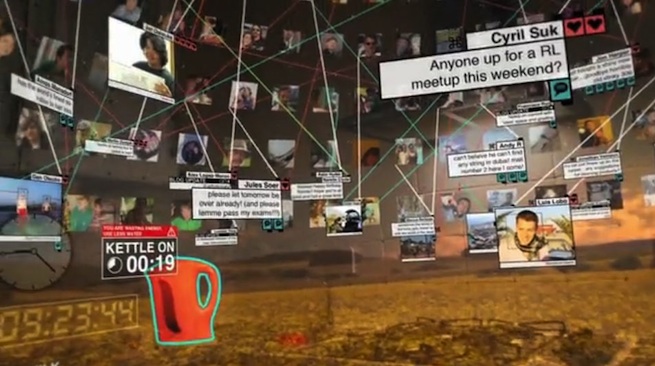
This is a guest post by Trak Lord
Augmented reality (AR) may seem like a futuristic concept, but it will be a reality of our digital lives in 2013. AR is a new technology that blurs the line between what’s real and what’s computer generated by enhancing what we hear, see and feel. Next year, I predict that it will be everywhere. Here are my five reasons why:
[aditude-amp id="flyingcarpet" targeting='{"env":"staging","page_type":"article","post_id":594801,"post_type":"guest","post_chan":"none","tags":null,"ai":false,"category":"none","all_categories":"business,","session":"D"}']The glasses are coming, the glasses are coming!
Whether it’s Google’s Project Glass or concept videos along the lines of “Sight”, the Internet can’t get enough of Terminator Vision. A few companies have however made some pretty impressive technological leaps this year: this fall, Vuzix debuted their monocular AR prototype for industrial use at the annual InsideAR conference; Innovega showcased their Augmented Reality contact lens prototype at the 2012 Consumer Electronic show, for which they’re currently seeking FDA approval; and researchers at the University of Washington successfully displayed a single pixel on an eye (albeit, that of a rabbit).
AI Weekly
The must-read newsletter for AI and Big Data industry written by Khari Johnson, Kyle Wiggers, and Seth Colaner.
Included with VentureBeat Insider and VentureBeat VIP memberships.
In the meantime, retails brands like Oakley and game favorite Valve were just as quick to throw their hats in the ring alongside patent applications from tech giants Apple and Microsoft. But don’t bother Santa with your letters – widely available (and affordable) wearable augmented reality devices probably won’t hit shelves until 2014.
Smartphones will be AR-equipped
We might not get Paul Smith AR goggles anytime soon, but expect OEMs, handset manufacturers and carriers to integrate optimized augmented reality, visual display and camera performance into the next generation of smartphones, because it’s basically already happening.
Premier-to-punchline-to-rising-star Nokia recently launched the City Lens app, exclusive to its Lumia suite of devices. UK-based chip designer ARM has had its eye on AR for a while, powering and optimizing experiences for its architecture found in the Samsung Galaxy SII, SIII and Note devices. And let us not forget Telefonica and their mad dash to serve mobile augmented reality advertisements to the entirety of their O2 network, alongside mobile coupons and location-based services.
Location, Location, Location
GPS and geodata were responsible early on for bringing augmented reality to the forefront. Applications like Junaio and Layar made a splash in the tech world, offering location-based navigational “channels” and “layers” where UFO-like billboards bobbed on the horizon, displaying information about your surroundings. In 2013 expect to see the next generation of those GPS-based experiences, incorporating not only data from on-board sensors like the gyroscope and camera, but other niche mobile technologies that rely on proximity such as NFC.
[aditude-amp id="medium1" targeting='{"env":"staging","page_type":"article","post_id":594801,"post_type":"guest","post_chan":"none","tags":null,"ai":false,"category":"none","all_categories":"business,","session":"D"}']
Companies like Hover are already deeply embedded in generating and augmenting 3-D maps of urban areas, and my company (AR firm Metaio) has successfully developed “snapping algorithms” that pull this kind of data from the cloud and tightly align it to the real world. Expect your city to get a lot more augmented in 2013.
The death of the gimmicky app
Disclaimer: there will always be marketers that abuse useful technology for their own nefarious, poorly designed purposes(re: QR codes), but expect to see brands move to better, faster and stronger apps that give their audience clear incentives for regular use. 3-D bunnies smiling at you from conference marketing material may have seemed novel at the time, but creating a new app for each one-off experience is neither scalable nor tolerable from a user’s perspective.
The 2013 IKEA Catalog app featured an augmented reality viewer that visualized furniture in 3-D and served related video and digital content to readers – and was the most downloaded branded app of 2012, even after launching in July. With that kind of success as a benchmark, expect other companies to start managing entire product lifecycles with augmented reality solutions- not unlike Mitsubishi Electric with their enterprise MeViewAR app that visualizes heating and cooling units in the real world. Mitsubishi Electric has already moved to the next phase for 2013, intending to visualize 3-D maintenance instructions for service technicians.
[aditude-amp id="medium2" targeting='{"env":"staging","page_type":"article","post_id":594801,"post_type":"guest","post_chan":"none","tags":null,"ai":false,"category":"none","all_categories":"business,","session":"D"}']
The birth of the elusive killer app
It doesn’t exist, and it probably won’t. Augmented Reality is a horizontal technology, which means that the nigh-limitless applications make it a challenging endeavor to develop the Evernote-YouTube-Wordpress-Instagram of Augmented Reality. We did however see the AR Angry Birds, and even if it isn’t official it’s still a pretty clear indication that a successful AR game could lead the way for massive adoption. There are already some good examples out there, like the new JengAR game that inserts the 3-D content into the environment itself rather than needing a printed image.
Expect more games to take this approach in 2013 as we move toward experiences that engage users in their actual surroundings. But the most amazing app for which the industry could possibly hope is only peripherally related to augmented reality. 3-D content is tough- it’s difficult and expensive and time-consuming to create, and may present the biggest barrier to producing augmented reality experiences. Augmented reality needs an app that easily generates 3-D content and exports it in major supported formats. Think “Draw Something” meets iMovie, in 3-D.
That would be something.
[aditude-amp id="medium3" targeting='{"env":"staging","page_type":"article","post_id":594801,"post_type":"guest","post_chan":"none","tags":null,"ai":false,"category":"none","all_categories":"business,","session":"D"}']
Since joining Metaio, Trak has traveled all over the world evangelizing augmented reality and Metaio’s research. He also manages Augmented Reality Blog, the most widely read source in the industry.
When he’s not at Metaio, Trak enjoys vintage motorcycles, 19th Century French novels and coffee. Lots of coffee.
VentureBeat's mission is to be a digital town square for technical decision-makers to gain knowledge about transformative enterprise technology and transact. Learn More
